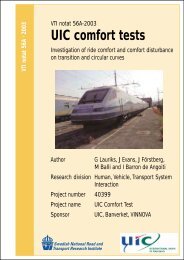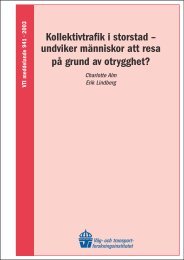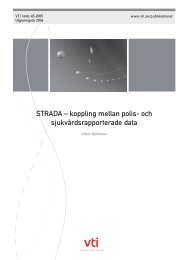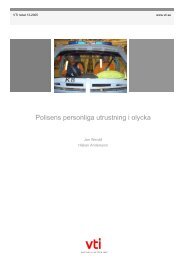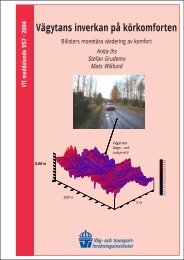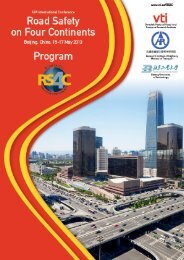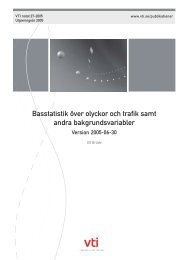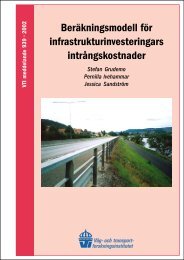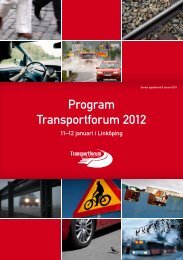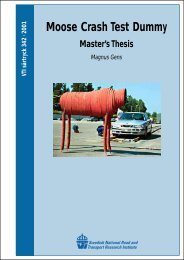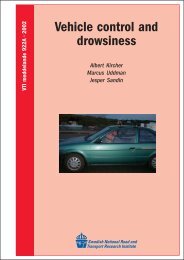You also want an ePaper? Increase the reach of your titles
YUMPU automatically turns print PDFs into web optimized ePapers that Google loves.
Low traffic volume roads - A litterature review concerning benefit, standard,<br />
condition, operation, and maintenance<br />
by Karin Edvardsson<br />
<strong>VTI</strong> (Swedish National Road and Transport Research Institute)<br />
SE-581 95 Linköping, Sweden<br />
Summary<br />
This research is the result of a literature study on low traffic volume roads. This report<br />
intends to provide a basis for a project proposal with an objective to develop new tools<br />
for creating a modern low traffic volume road network, adapted for future requirements.<br />
Low traffic volume roads include all roads with a traffic volume of up to 1,000 vehicles<br />
per day. In principle, only Nordic studies were considered in this report since the Nordic<br />
climate, road construction practices, and maintenance traditions may differ to some<br />
extent from the rest of the world.<br />
In summary, a large amount of literature treats condition measurements and reinforcement,<br />
particularly methods for these. However, there is not much research on the actual<br />
road network status, degradation models and life cycle costs published.<br />
Low traffic volume roads have low traffic intensity but it may be noted that it is the<br />
same people who often use these roads and therefore incur increased operating costs and<br />
reduced comfort. Often, these road users also are completely dependent on the existence<br />
of the roads. On the paved low traffic volume roads, road users are bothered most by<br />
potholes, unevenness and poor pavement repairs. On gravel roads, the corresponding<br />
types of defects are potholes, corrugations and frost damages. These types of defects, on<br />
paved as well as gravel roads, also cause most damage to vehicles.<br />
The structural condition of the road is the most critical parameter for the asset value of<br />
the low traffic volume road network. Road capacity affects accessibility for freight<br />
transports and is therefore of great importance to the forest industry. Every year about<br />
20 000 km of roads get frost restrictions, the cost of which for forestry companies solely<br />
is estimated to be between 700 and 900 million Swedish crowns per year. Therefore, the<br />
most viable solution, to address the problem of reduced bearing capacity, is to reinforce<br />
weak sections. However, this requires that sufficient resources are available to take<br />
long-term measures. Major problems have arisen when the road section has been<br />
reinforced with a design that is too weak; problems that become particularly apparent if<br />
the road is paved afterwards.<br />
Degradation of low traffic volume roads is more complex than on heavily trafficked<br />
roads where traffic is the most important parameter. At low traffic volume roads, there<br />
is a longer time horizon as well as the fact that several parameters, such as the aging,<br />
durability, and climate interact.<br />
The life length of a road increases significantly when the drainage is improved.<br />
Calculations, using PMS Object, have shown that the life length of a road construction<br />
increases by a factor 2.2 to 2.6 when the drainage system is improved from poor to good<br />
condition. Thus, life cycle costs (LCC) calculations show that it is profitable to keep<br />
drainage in good condition. If the pavement's length of life can be doubled and the<br />
discount rate is 4%, the drainage system may cost € 8,400/km every five years and life<br />
<strong>VTI</strong> rapport 775 9



